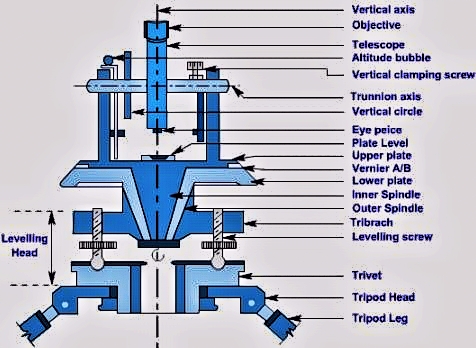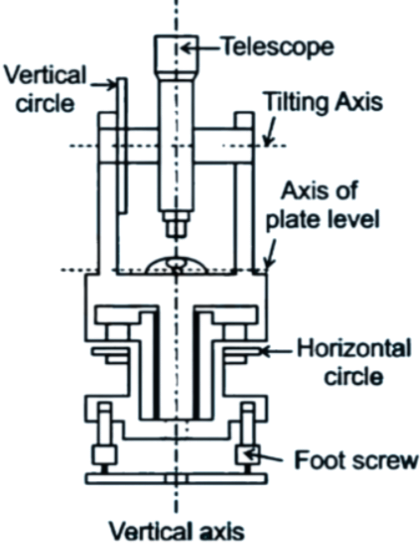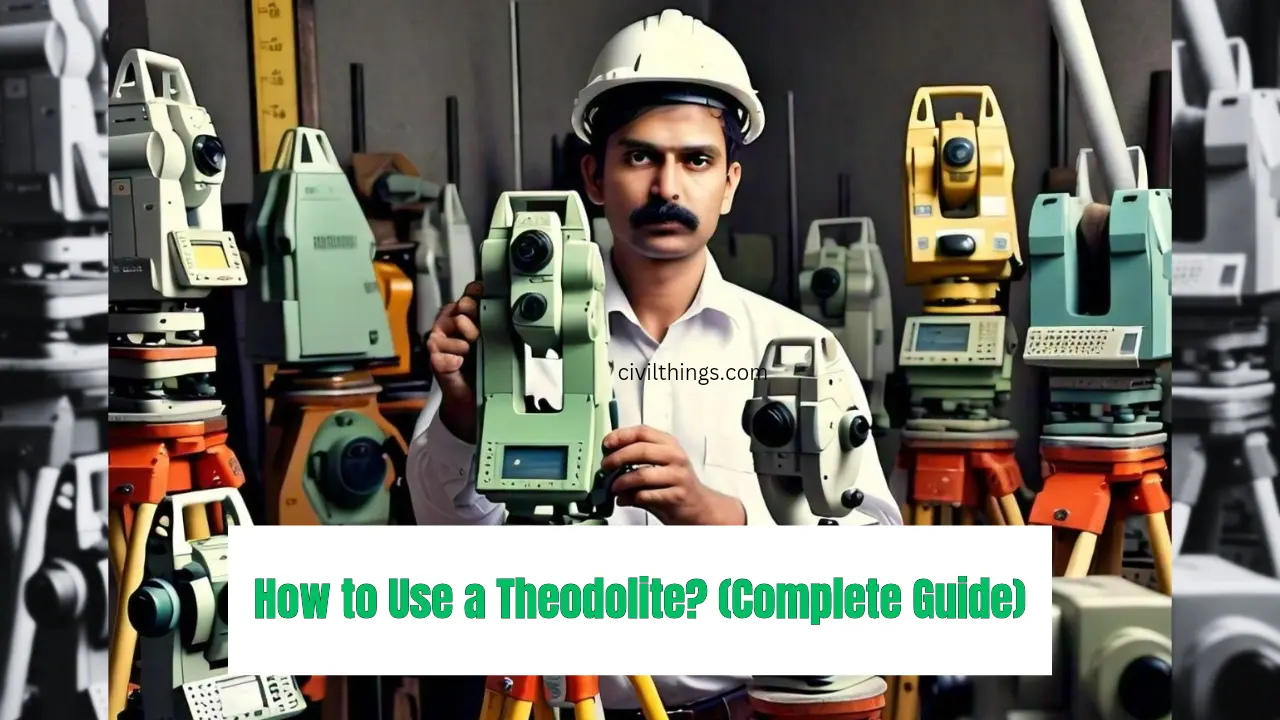Table of Contents
Theodolite is one of the most essential surveying instruments widely used in civil engineering and construction projects. It is primarily used to measure horizontal and vertical angles with high precision. This blog post is a complete guide on how to use a theodolite effectively.
Whether you are a beginner or an experienced civil engineer, this guide will help you understand the components, setup, and practical usage of a theodolite. Let’s dive into the details!
What is a Theodolite?
A theodolite is a precision instrument used for measuring angles in horizontal and vertical planes. It is extensively used in surveying, engineering, and construction to establish points and determine alignments.
Key Features of a Theodolite
- Measures horizontal and vertical angles.
- Provides highly accurate readings.
- Rotates 360 degrees for full circular measurements.
- Can be mounted on a tripod for stability.
मराठीत: थेओडोलाइट हा सर्वेक्षण आणि बांधकाम क्षेत्रात कोन मोजण्यासाठी महत्त्वाचा साधन आहे. याच्या मदतीने क्षैतिज आणि उभ्या कोनांचे अचूक मापन करता येते.
Parts of a Theodolite

Understanding the parts of a theodolite is essential before you begin using it. Here is a detailed breakdown:
| Part Name | Function |
|---|---|
| Telescope | Used to view and align objects. |
| Horizontal Circle | Measures horizontal angles. |
| Vertical Circle | Measures vertical angles. |
| Leveling Screws | Used for leveling the theodolite. |
| Plumb Bob | Helps in centering the instrument over a ground point. |
| Tripod | Provides a stable base for the theodolite. |
| Focusing Knob | Adjusts the focus of the telescope for a clear view. |
| Vernier Scale | Reads fine adjustments for precise angle measurement. |
Step-by-Step Guide to How to Use a Theodolite?
1. Setting Up the Theodolite

i. Select a Stable Ground
Choose a flat and stable ground to set up your theodolite. Ensure the ground is free from vibrations or movements that could impact the readings.
ii. Mount the Theodolite on the Tripod
- Attach the theodolite to the tripod using the mounting screw.
- Ensure the instrument is securely fixed to avoid wobbling.
iii. Level the Theodolite
- Adjust the leveling screws until the bubble in the spirit level is centered.
- Use the foot screws to make fine adjustments.
2. Centering the Theodolite
- Use the plumb bob to center the theodolite over the survey point.
- Adjust the tripod legs to ensure the instrument is positioned accurately over the desired location.
3. Measuring Angles with the Theodolite
i. Horizontal Angle Measurement
- Align the telescope with the first point (Point A).
- Clamp the horizontal motion lock to fix the position.
- Rotate the telescope to the second point (Point B).
- Read the horizontal angle from the graduated circle.
ii. Vertical Angle Measurement
- Align the telescope to the desired point.
- Lock the vertical motion clamp.
- Read the vertical angle from the vertical circle.
Applications of Theodolite in Surveying
Theodolites are used for various tasks, such as:
- Establishing property boundaries.
- Measuring angles for building layouts.
- Calculating height differences.
- Aligning structures like bridges and roads.
मराठीत: थेओडोलाइटचा उपयोग प्रॉपर्टीचे सीमांकन करण्यासाठी, इमारतींच्या आराखड्यांमध्ये कोन मोजण्यासाठी, उंचीतील फरक मोजण्यासाठी आणि पूल व रस्ते यांचे संरेखन करण्यासाठी केला जातो.
Tips for Accurate Theodolite Readings
- Always level the theodolite properly before taking measurements.
- Use the vernier scale for precise readings.
- Protect the theodolite from dust and moisture to maintain accuracy.
- Double-check all measurements for consistency.
Common Mistakes to Avoid
- Improper leveling: This can lead to inaccurate readings.
- Loose tripod: Ensure the tripod is stable before use.
- Misalignment: Always double-check the alignment before recording angles.
Advantages of Using a Theodolite
- High accuracy in angle measurements.
- Versatile applications in surveying and construction.
- Durable and reliable for long-term use.
Theodolite vs. Total Station
| Feature | Theodolite | Total Station |
|---|---|---|
| Function | Measures angles only | Measures angles and distances |
| Cost | Affordable | Expensive |
| Technology | Manual | Digital |
| Application | Traditional surveying | Modern and advanced surveying |
Conclusion
Theodolite is an indispensable tool for surveyors and civil engineers. Understanding how to use it correctly is crucial for accurate results. Follow the steps mentioned in this guide to set up and operate the theodolite efficiently.
By mastering the use of a theodolite, you can ensure precision and reliability in your surveying projects, whether it’s property mapping, road alignment, or building construction.
Frequently Asked Questions (FAQ) About Theodolite
1. What is a theodolite used for?
A theodolite is primarily used for measuring horizontal and vertical angles in surveying and construction projects. It is commonly used for property boundary mapping, road alignment, and building layout.
2. How does a theodolite work?
A theodolite works by rotating its telescope on horizontal and vertical axes. Angles are measured using graduated circles with precise markings, and readings are taken using vernier scales or digital displays.
3. What are the main components of a theodolite?
The main components of a theodolite include:
- Telescope
- Horizontal and vertical graduated circles
- Leveling screws
- Tripod
- Vernier scale or digital screen
4. How accurate is a theodolite?
A standard theodolite provides accuracy up to 1 arc-second for angle measurements. Digital theodolites offer even higher precision. Proper leveling and setup ensure maximum accuracy.
5. What is the difference between a theodolite and a total station?
- Theodolite: Measures only angles (horizontal and vertical).
- Total Station: Measures both angles and distances and integrates advanced digital features like data recording and GPS.
6. How do you level a theodolite?
To level a theodolite:
- Adjust the tripod legs to make the instrument roughly horizontal.
- Use the leveling screws to center the bubble in the circular spirit level.
- Repeat the adjustment until the instrument is perfectly level.
7. Can a theodolite measure distances?
No, a theodolite does not directly measure distances. However, it can be used with external tools like a measuring tape or rangefinder for distance calculations.
8. How do I maintain a theodolite?
- Store the theodolite in a protective case when not in use.
- Clean the lenses with a soft cloth.
- Avoid exposing it to moisture or dust.
- Calibrate it regularly to maintain accuracy.
9. Is theodolite still used in modern surveying?
Yes, theodolites are still used for specific applications requiring only angle measurements. However, total stations and GPS devices are becoming more popular for advanced surveying needs.
10. What is the cost of a theodolite?
The cost of a theodolite depends on its type:
- Manual Theodolite: ₹15,000 to ₹40,000 (approx.)
- Digital Theodolite: ₹50,000 to ₹1,50,000 (approx.)
11. Can I use a theodolite without prior experience?
Basic theodolite operations, like setup and angle measurement, can be learned quickly with guidance. However, achieving precise results requires practice and knowledge of surveying principles.
12. How is a theodolite aligned with a survey point?
Theodolite alignment is done using a plumb bob to position the instrument directly over the survey point. Fine adjustments are made using the foot screws and sighting through the telescope.
13. What are the alternatives to a theodolite?
Alternatives to theodolites include total stations, GPS survey devices, and laser levels, which offer more advanced features like distance measurement and automated calculations.
14. What are the limitations of a theodolite?
- Cannot measure distances directly.
- Requires manual setup and leveling.
- Accuracy depends on user expertise.
- Limited functionality compared to modern devices like total stations.
15. How do I choose the right theodolite for my project?
Consider these factors:
- Purpose: For basic angle measurements, a manual theodolite is sufficient. For advanced projects, choose a digital model.
- Budget: Select a theodolite within your price range.
- Features: Ensure the theodolite has the required precision and durability for your project.
If you have further questions, feel free to comment below or contact us for more details!
Download Complete Guide How to Start Surveying Business using Theodolite

Hi! I’m Sandip, a civil engineer who loves sharing about Civil Engineering & new ideas and tips. My blog helps you learn about engineering in a fun and easy way!


1 thought on “How to Use a Theodolite? (Complete Guide) For Civil”
Comments are closed.